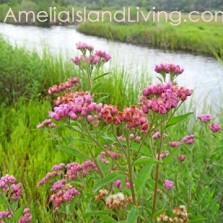
QUESTION: I found a wildflower with clusters of light purple flowers behind my house which is near Egans Creek marsh. Do you know what it is? TK
JORDI: I was glad you brought me photos of it. I went back and looked for it myself then sent my own photos to the University of Florida. They identified the wildflower as most likely camphorweed in the genus Pluchea. It is often found in bogs, woodlands, pastures, swamps and floodplains. It is native to North America and a common wildflower in Florida.
The common name “camphorweed” comes from the plant emitting a camphor-like odor when crushed or broken. The wildflower blooms from late summer to early fall. It is listed as endangered in Ohio and Maryland. Camphorweed, like so many other wildflowers, are a food source for birds and butterflies.
QUESTION: In one of your teaching sessions you mentioned not piling mulch up around the trunk of trees. Everyone does it, so what kind of problems does it cause? JM
JORDI: Good question and I actually have a couple of photos which show the water damage on a crape myrtle from too much mulch or mulch “volcanoes”. I wish mulch volcanoes were not a common practice in landscapes and on commercial property. I believe it will take some time before we can change this inappropriate practice, but we keep trying.

Trees in urban settings have enough stresses without putting on additional ones such as too much mulch and moisture. This is so easy to fix. Remove the mulch from around the base of the tree and move it out (2-3 inches deep only) under the canopy of the tree. While you are removing the mulch, you might also check to see if the tree has too much soil on the roots too. The combination of the two (too much mulch and soil) can prove deadly. The photo I included shows circling/girdling roots really close to the trunk – not a good thing either. All these issues (too much soil and mulch, circling/girdling roots) can be corrected at the same time. Your tree will be so appreciative and happy.
QUESTION: My son and I were walking in the woods recently and we came upon a walking stick. He was full of questions. What can you tell me about them? SA
JORDI: These insects belong to the insect order Phasmida. All of the species are chewing insects which feed on the leaves of plants. The name “walkingstick” comes from their thin, slender body forms. They look like slender twigs or branches mimicking where they live, which helps them hide from predators. In addition, glands located on the thorax of many species can produce a foul-smelling liquid that repels predators.

The seed-like eggs are dropped singly onto the ground, sometimes from great heights where they may remain dormant for more than a year before hatching. In our area, walkingsticks are seldom abundant enough to cause injury to their host plants. When attacked by a predator, the legs of some phasmids may separate from the body. Some species can even regenerate lost legs at the next molt. These are the only insects able to regenerate body parts. Host plants include apple, basswood, birch, dogwood, hackberry, hickory, locust, oak, pecan and wild cherry.

543350 U. S. Highway #1
Callahan, Florida 32011
E-mail: [email protected]
Phone: 904-491-7340
